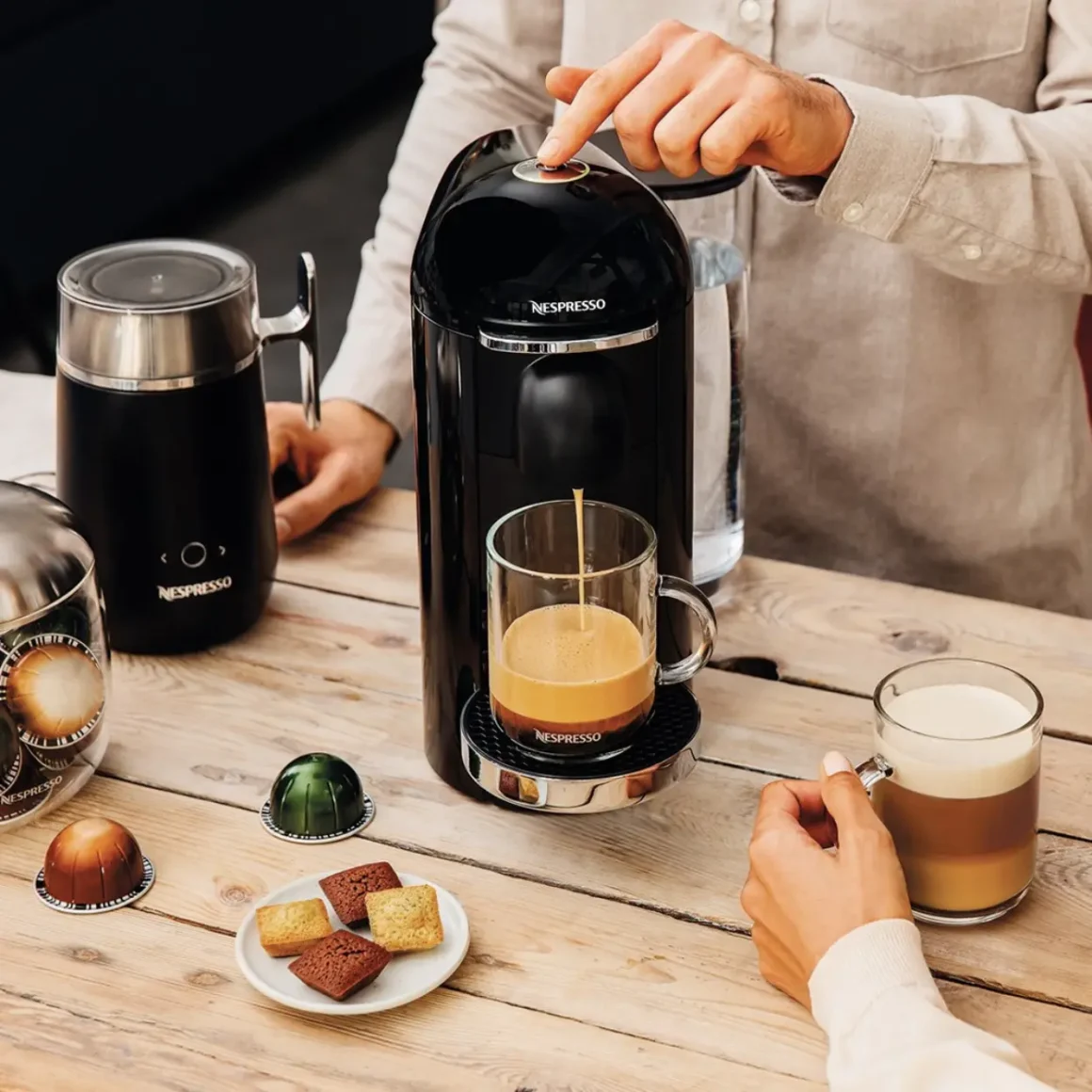In the global community of coffee brewing, the debate of Moka Pot vs Nespresso stands out as a topic of interest for both coffee aficionados and everyday drinkers alike. This guide aims to provide an in-depth comparison between these two popular brewing methods, each celebrated for its unique approach to coffee making. While the Moka Pot is revered for its traditional brewing technique and rich, robust coffee, Nespresso brings modern convenience and consistency to the table with its innovative pod-based system. Understanding the differences in taste, user experience, and practicality of these methods is essential for anyone looking to enhance their coffee routine.
Nespresso vs Moka Pot: Brewing Process Comparison

Coffee enthusiasts often debate the merits of different brewing methods, seeking to extract the best flavors from their beans. Two popular methods are the Nespresso and Moka Pot systems, each offering unique processes and results.
How to Use a Moka Pot: Brewing Process

The Moka Pot, a stovetop coffee maker, has been a staple in many households for decades. Its operation is relatively straightforward but requires a hands-on approach:
- Water and Coffee Grounds Preparation: Begin by filling the lower chamber with water just below the valve and adding finely ground coffee to the filter basket. (1)
- Heating: Assemble the pot and place it on the stove. Heat should be moderate to prevent the coffee from burning.
- Extraction Process: The heat forces the water upwards through the coffee grounds, extracting flavor. The brewed coffee then accumulates in the upper chamber.
- End of Brewing: Once you hear a hissing, bubbling sound, the brewing is complete. Remove the pot from the heat to prevent over-extraction.
Nespresso Brewing Process

The Nespresso system, on the other hand, represents modern convenience with its Coffee pod machine. Its process is characterized by simplicity and speed:
- Insertion of Coffee Pod: Choose a capsule and insert it into the coffee pod machine. The best Nespresso machine typically offers a variety of settings and flavors.
- Automatic Brewing: With a press of a button, the machine pierces the pod and hot water passes through the ground coffee at high pressure.
- Consistent Output: The machine controls the volume and temperature, ensuring a consistent cup every time.
Flavor Differences

When it comes to flavor, both methods have their enthusiasts:
- Moka Pot Coffee: Known for its strong, rich flavor, it is often compared to espresso but has a unique taste profile. The method extracts intense flavors and can have a slight bitterness.
- Nespresso: Offers a cleaner, more consistent taste with a wide range of flavor options due to the variety of pods. It tends to produce a smoother cup with less bitterness.
Choosing between both coffee machines depends on personal preferences regarding convenience, control, and flavor profile. The stovetop coffee machine offers a more traditional, hands-on approach with a robust flavor, while Nespresso provides a quick, consistent, and convenient coffee experience with a wide range of flavors.
Moka Pot vs Nespresso: Pros and Cons

The debate between these two coffee makers’ methods is ongoing among coffee enthusiasts. Each has distinct advantages and disadvantages, shaping the coffee experience they offer.
Moka Pot Pros
Several key benefits come to mind when considering the advantages of using this coffee pot for your coffee brewing needs.
- Rich Flavor Profile: The best moka pot is renowned for extracting strong, rich coffee, akin to espresso but with a unique character.
- Affordability: Generally, these coffee makers are more affordable than electric ones, making them accessible to a wider audience.
- No Electricity Required: This stovetop method doesn’t rely on electricity, making it ideal for use in various settings, including outdoors.
- Durability and Longevity: These coffee pots are often made of durable materials like aluminum or stainless steel, ensuring a long lifespan with proper care.
Moka Pot Cons
It’s essential to be aware of some potential drawbacks associated with this coffee pot brewing.
- Manual Operation: Brewing with this coffee maker requires more attention and skill, which might be challenging for some users.
- Consistency: Achieving consistent results can be difficult, as it depends on factors like grind size, heat, and timing.
- Limited Variety: This coffee machine is typically used for making a strong, espresso-like coffee, offering less variety in coffee styles.
Nespresso Pros
Nespresso machines offer their unique set of advantages that cater to a different set of preferences.
- Convenience and Speed: The Nespresso coffee maker exemplifies ease of use and quick brewing, ideal for busy lifestyles.
- Consistency: With pre-measured Nespresso coffee pods, each cup is consistent in flavor and strength.
- Variety of Flavors: A wide range of pod options allows users to explore different coffee styles and flavors.
- Compact and Stylish Design: Nespresso machines often feature a sleek design, fitting well in modern kitchens.
Nespresso Cons
While Nespresso machines have their merits, there are also some drawbacks to consider when using this coffee-making method.
- Cost: Nespresso machines and their pods can be more expensive than traditional brewing methods.
- Environmental Impact: Coffee pods create more waste than traditional coffee grounds, although recycling programs are available. (2)
- Dependence on Electricity: Being an electric appliance, it requires power, limiting its use in certain environments.
- Customization Limitations: While offering variety, Nespresso machines limit how much you can customize the brewing process compared to manual methods.
The stovetop coffee maker offers a traditional, hands-on coffee brewing experience with rich flavor but requires more skill and effort. In contrast, the Nespresso system provides a convenient, consistent, and diverse coffee experience but at a higher cost and with less environmental efficiency. The choice largely depends on individual preferences for convenience, flavor, and lifestyle.
Taste and Quality of Moka Pot and Nespresso
The worldwide industry of coffee is rich in brewing methods, each of them resulting in a unique flavor sensation. The Moka Pot and Nespresso systems stand out for their unique methods of coffee brewing, resulting in a variety of tastes and attributes.
Moka Pot Taste and Aroma

When it comes to the taste and aroma of coffee brewed using this coffee pot, several distinctive characteristics stand out.
- Robust Flavor: Often referred to as stovetop espresso, this coffee pot, as previously discussed, is known for producing coffee with a robust and rich flavor. This method extracts a concentrated coffee, similar to traditional espresso but with its own unique characteristics.
- Intensity and Complexity: The coffee from this pot typically has a higher intensity and complexity of flavors compared to standard drip coffee. The heat and pressure involved in this method extract deep and nuanced aromas from the coffee grounds.
- Bitterness and Body: A cup from this coffee maker is also known for its slight bitterness and significant body. This can be appealing to those who enjoy a strong cup of joe with a pronounced mouthfeel.
Nespresso Taste and Aroma

Nespresso coffee machines offer a different coffee experience, marked by specific taste and aroma qualities.
- Consistent and Clean Flavor: Nespresso machines, using espresso coffee in pod form, deliver a consistently clean and balanced cup of coffee. The precision of the machine ensures a stable extraction process, which is key to maintaining flavor consistency.
- Variety of Flavors: As mentioned before, the wide range of Nespresso pods available offers a spectrum of flavors and intensities, catering to different taste preferences. From light and fruity to dark and intense, there is a pod for every palate.
- Aroma Preservation: The sealed pods used in Nespresso machines help preserve the freshness and aroma of the coffee, ensuring a high-quality taste experience in each cup.
Crema Comparison

Let’s also explore the crema, a significant aspect of coffee aesthetics and flavor, produced by both brewing methods.
- Moka Pot Crema: The crema produced by this coffee pot is typically thinner and less pronounced than that of an espresso machine. However, it still adds a slight richness and complexity to the coffee.
- Nespresso Crema: Nespresso machines are known for producing a thick, rich crema, similar to what is found in professionally brewed espresso. This crema adds a smooth texture and enhances the overall sensory experience of the coffee.
In summary, both coffee makers offer distinct taste profiles and qualities. The stovetop coffee maker is favored for its intense and complex flavors, reminiscent of stovetop espresso, while Nespresso offers a wide range of flavors with a consistent, high-quality aroma and a notable crema. The choice between the two often comes down to personal preference in taste, the intensity of the coffee, and the desire for variety.
Moka Pot and Nespresso: User Experience
When it comes to coffee brewing, the user experience is a crucial aspect that can significantly influence one’s choice of equipment. Both coffee makers offer distinctly different experiences in terms of brewing control, maintenance, as well as speed, and convenience.
Brewing Control

Stovetop coffee makers allow manual control but demand practice, while Nespresso offers automated brewing with limited adjustments but a wide flavor selection.
Moka Pot:
- Hands-On Approach: This coffee maker allows for a more hands-on brewing experience. Users can control various aspects like the grind size, the amount of coffee, and the heat source.
- Skill and Practice Required: Achieving the perfect brew with this coffee machine often requires practice and an understanding of the brewing process.
- Customization: Users have the flexibility to experiment with different coffee types and brewing times to tailor the flavor to their preferences.
Nespresso:
- Automated Brewing: Nespresso machines provide an automated brewing process. The machine controls the pressure, temperature, and timing, ensuring a consistent cup every time.
- Limited Manual Control: There is minimal scope for manual adjustments in the brewing process, as the machine and Nespresso coffee pods are designed to work together for optimal results.
- Flavor Options: While manual control is limited, users can choose from a wide range of coffee pod flavors and intensities.
Maintenance

Stovetop coffee makers need regular cleaning and last longer, while Nespresso machines are easy to clean but require descaling and pod disposal.
Moka Pot:
- Regular Cleaning Required: These coffee pots require thorough cleaning after each use to maintain their functionality and prevent residue build-up.
- Durability: With proper care, these pots are highly durable and can last for many years.
- No Electrical Components: The absence of electrical components makes them easier to maintain over time.
Nespresso:
- Simple Cleaning Process: Nespresso machines are generally easy to clean, with many models featuring automated cleaning cycles.
- Descaling: Periodic descaling is necessary to keep the machine in optimal condition. (3)
- Pod Disposal: Users need to regularly dispose of used coffee pods, which adds an extra step to the maintenance routine.
Speed and Convenience

Moka Pots are time-consuming and suitable for ritualistic brewing. Nespresso is quick and user-friendly for a convenient coffee experience.
Moka Pot:
- Time-Consuming Process: Brewing with this stovetop coffee maker is more time-consuming and requires constant attention during the brewing process.
- Ideal for Ritualistic Brewers: It suits those who enjoy the ritual of brewing and have the time to dedicate to the process.
Nespresso:
- Quick and Efficient: Nespresso machines are designed for speed and convenience, brewing a cup of coffee in just a few minutes.
- User-Friendly: Their straightforward operation makes them ideal for those seeking a quick, hassle-free coffee experience.
Overall, both coffee machines offer contrasting experiences to the user. The stovetop coffee maker caters to those who enjoy a more involved and customizable brewing process, while Nespresso appeals to users seeking a quick, consistent, and easy-to-maintain coffee solution. The choice between the two largely depends on one’s lifestyle, time constraints, and interest in the coffee brewing process.
Conclusion
In conclusion, the Nespresso vs Moka Pot debate encapsulates two very different approaches to coffee brewing, each with its unique set of benefits and considerations. The Moka Pot, with its traditional and hands-on brewing method, appeals to those who savor the ritual of coffee making and enjoy a rich, robust flavor profile. On the other hand, the Nespresso system offers unparalleled convenience and consistency, making it a favorite for those who appreciate quick, hassle-free coffee preparation with a variety of flavor choices. Ultimately, the decision between these coffee machines comes down to personal preference in terms of taste, involvement in the brewing process, and lifestyle needs.
FAQ
What is the difference in cost between brewing with a Moka Pot and using Nespresso capsules?
Brewing with a Moka Pot is typically more cost-effective in the long run, as Nespresso capsules usually have a higher cost per serving.
Which brewing method offers a more authentic espresso taste?
The stovetop coffee maker offers a taste closer to authentic espresso, with a more robust flavor profile than Nespresso.
How do Moka Pot and Nespresso compare regarding environmental sustainability?
The coffee pot is generally more environmentally sustainable, as it does not require disposable capsules like Nespresso and produces less waste.
Which coffee machine is better for those who enjoy experimenting with different coffee blends and grinds?
The stovetop coffee maker is better suited for those who enjoy experimenting with different coffee blends and grinds, offering more flexibility in customization.












